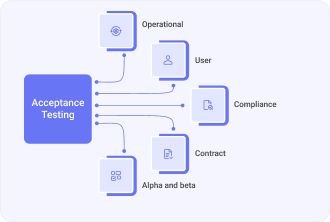Acceptance Testing Definition

Acceptance Testing is referring to a process which is conducted during quality assurance (QA) testing that is entailing the determination of to which extend the users are satisfied with the application and to which degree it meets their expectations. In the result the acceptance test can be either passed or failed which means it either meets the requirements or if the bugs or other issues are present within the app.
Based on the specific type of the quality assurance process this form of a test can be considered as beta testing, end user testing as well as application or field testing. The purpose described for the test of acceptance is to help the development team hit the nail on the head in terms of business goals and objectives to see how close they got it to match.
The five types of acceptance testing
As we have mentioned in the previous section the types of testing for acceptance can be varied and respond to a specific amount of criteria and for the purpose of keeping it simple we will go over the five most widely used forms of this kind of testing method. Here is what they are:

As we have mentioned in the previous section the types of testing for acceptance can be varied and respond to a specific amount of criteria and for the purpose of keeping it simple we will go over the five most widely used forms of this kind of testing method. Here is what they are:
- Operational acceptance testing is conducted with a goal of finding out whether the software is according to the requirements and therefore ready to be deployed.
- User acceptance testing as we talked about earlier is aimed at figuring out if the software is resonating with the needs of end users and ifit functions appropriately in real world scenarios.
- Compliance acceptance testing as the name implies is done for the reason of establishing if the final solution is in compliance with the local regulatory and legal compliances.
- Contract acceptance testing is similar to operational testing in some ways as it also is focused on getting to the bottom of whether the solution meets the expectations written out within the contractual agreement.
- Alpha and beta acceptance testing is referring to the first part of conducting tests to find faults before the release of the software and the latter part is focused on getting the feedback from real users after the initial deployment.
Benefits of acceptance testing
The value acceptance testing brings to the table during and after the development process has been completed is hard to underestimate as one of the major reasons for its performance is to improve the perception of users in terms of the software.
This is ultimately leading into the point of upgrading the quality of the solution as you will be in charge of making sure the quality is up to the standard and fits the market. Into the bargain setting aside time and effort for acceptance testing is going to prove useful in saving your budget resources since early bug detection can be less experience than fixing issues down the line when the software is already released.
Tips for acceptance testing
As it is your moment to step up to the plate and show that solution actually meets end-users requirements and can face real-world challenges you definitely need tips that facilitate such a complex yet engaging process. Here are some of them from our middle and senior testers:
- Get time and prepare
You have to determine which aspects have to be tested so it is advisable to come up with essential data, user scenarios, and even make a checklist if you feel that there are many on the plate.
- Focus on real usage
It is not just a nice-to-conduct test but the one that is responsible for usability across every button coders and designers created, ensuring that it leads to the direct page and users will not spend time confused with what to click.
- Cooperate with other experts.
With any doubts for the core features, you can share your questions and feedback with those who made the software, work hand-in-hand with them to ensure it works well as it should be in the plan.
To summarize all being said keep your hand on the pulse of project and pay attention to minor inconveniences that may affect the user flow.